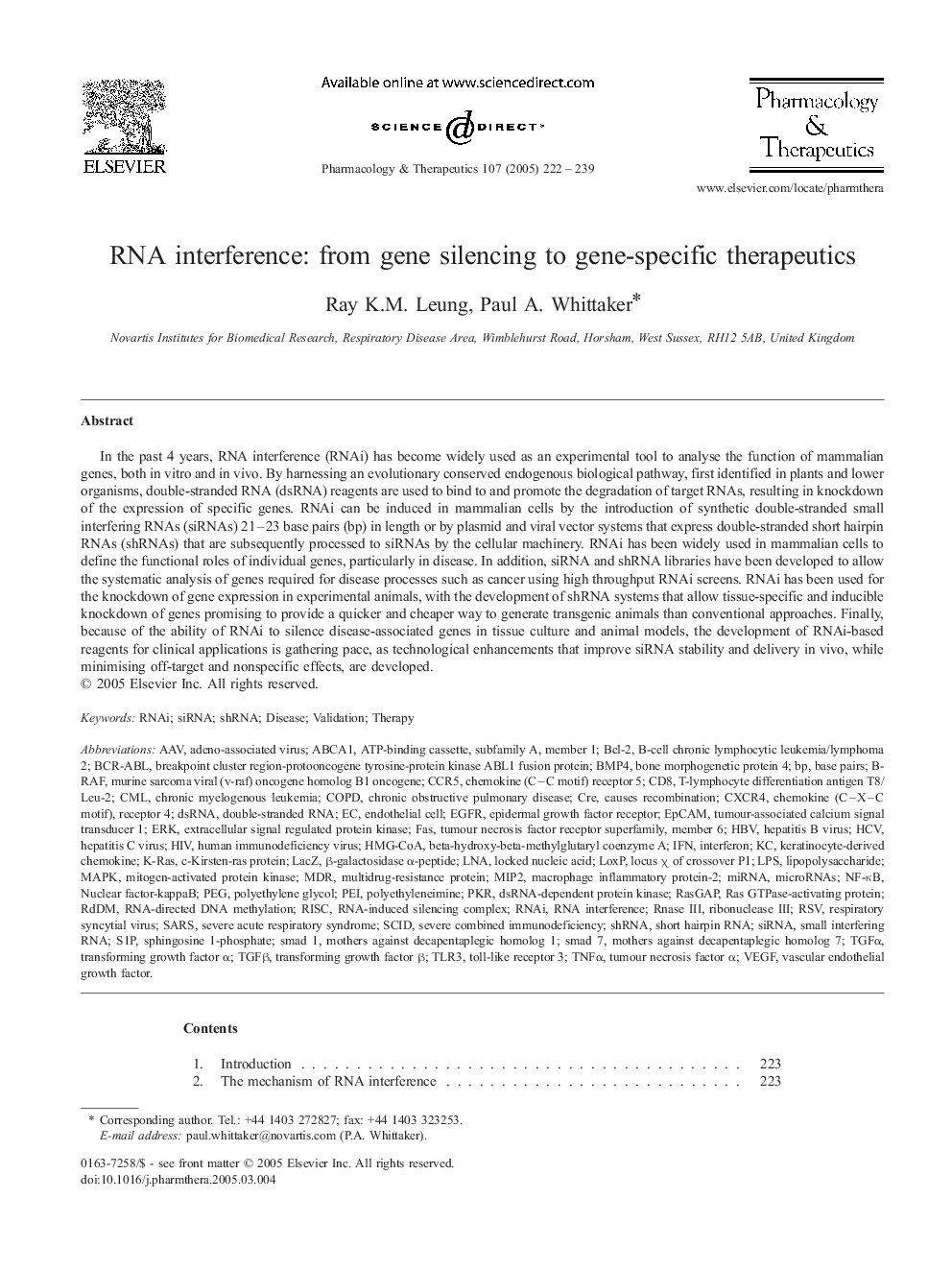| Article ID | Journal | Published Year | Pages | File Type |
|---|---|---|---|---|
| 9015872 | Pharmacology & Therapeutics | 2005 | 18 Pages |
Abstract
In the past 4 years, RNA interference (RNAi) has become widely used as an experimental tool to analyse the function of mammalian genes, both in vitro and in vivo. By harnessing an evolutionary conserved endogenous biological pathway, first identified in plants and lower organisms, double-stranded RNA (dsRNA) reagents are used to bind to and promote the degradation of target RNAs, resulting in knockdown of the expression of specific genes. RNAi can be induced in mammalian cells by the introduction of synthetic double-stranded small interfering RNAs (siRNAs) 21-23 base pairs (bp) in length or by plasmid and viral vector systems that express double-stranded short hairpin RNAs (shRNAs) that are subsequently processed to siRNAs by the cellular machinery. RNAi has been widely used in mammalian cells to define the functional roles of individual genes, particularly in disease. In addition, siRNA and shRNA libraries have been developed to allow the systematic analysis of genes required for disease processes such as cancer using high throughput RNAi screens. RNAi has been used for the knockdown of gene expression in experimental animals, with the development of shRNA systems that allow tissue-specific and inducible knockdown of genes promising to provide a quicker and cheaper way to generate transgenic animals than conventional approaches. Finally, because of the ability of RNAi to silence disease-associated genes in tissue culture and animal models, the development of RNAi-based reagents for clinical applications is gathering pace, as technological enhancements that improve siRNA stability and delivery in vivo, while minimising off-target and nonspecific effects, are developed.
Keywords
TLR3RNase IIIBcl-2ERKABCA1LNACMLBMP4AAVSCIDTGFαS1PCXCR4HMG-CoACD8CCR5PEIRSVPKREpCAMdsRNAK-RasB-RafLoxPRasGAPribonuclease IIIBCR-ABLSmad 7MIP2lacZRdDMEGFRMDRLPSTNFαCRETGFβcauses recombinationshRNAFASNF-κBMAPKRNA interferenceSmall interfering RNAdouble-stranded RNARNAishort hairpin RNAsiRNAsphingosine 1-phosphateLocked Nucleic AcidValidationinterferonIFNDiseaseChronic obstructive pulmonary diseaseCOPDtransforming growth factor αTransforming growth factor βtumour necrosis factor αbase pairsRISCTherapymicroRNAsSARSEndothelial cellsevere acute respiratory syndromeextracellular signal regulated protein kinaseVascular endothelial growth factorVascular Endothelial Growth Factor (VEGF)nuclear factor-kappaBchronic myelogenous leukemialipopolysaccharidemacrophage inflammatory protein-2RNA-directed DNA MethylationRNA-Induced Silencing ComplexMiRNAHBVHCVHepatitis C virusAdeno-associated virusRespiratory syncytial virushuman immunodeficiency virusHIVhepatitis B virusmultidrug-resistance proteinbone morphogenetic protein 4mitogen-activated protein kinasepolyethylene glycolpolyethyleneiminePEGsevere combined immunodeficiencyKeratinocyte-derived chemokineEpidermal growth factor receptorToll-like receptor 3
Related Topics
Health Sciences
Pharmacology, Toxicology and Pharmaceutical Science
Pharmacology
Authors
Ray K.M. Leung, Paul A. Whittaker,
